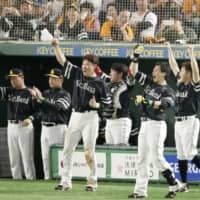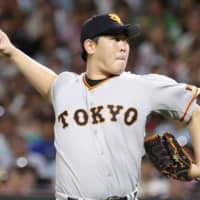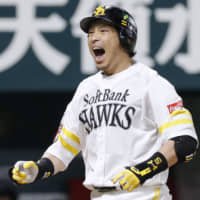Ever heard the one about the guy who had to walk 5 km, uphill, through a hailstorm just to get to school every day?
That’s essentially the tale the Sawamura Award selection committee told everyone Monday by deciding not to give out the award for the first time in 19 years.
Not because there wasn’t a pitcher dominant enough to be honored — a reason which might actually add more prestige to the award — but basically that pitchers these days have it too easy.
The main gripe this year was how changes in the game have resulted in pitchers throwing fewer complete games and pitching fewer innings than in past decades.
The gripe by baseball fans going forward should be that even the Sawamura Award cannot be immune to change and must evolve.
This year’s Sawamura committee consisted of former pitchers Tsuneo Horiuchi, Masaji Hiramatsu, Manabu Kitabeppu, Choji Murata and Hisashi Yamada. They gathered on Monday in Shinagawa ostensibly to announce a winner, but instead delivered an indictment on a game that doesn’t resemble the one they once excelled at.
They lamented changes that have seen relievers used more and starters pulled shortly after 100 pitches, something probably unthinkable during the eras when they pitched.
“Even among professionals, the pitcher will be replaced when he goes over 100 pitches,” Yamada said. “That leads to the reduction of complete games or innings pitched. The dividing of roles has been established. But I feel baseball has gone in that direction too much.”
But time goes on and things change. Strategies change, and teams and players become more attuned to what’s good for long term health and what isn’t.
The first Sawamura winner, Takehiko Bessho, threw 47 complete games in 1947. Daichi Osera led NPB this season with six. It’s not the same game from that standpoint.
If the Sawamura committee doesn’t adjust — not lower, adjust — its expectations with the times, it risks relegating the award to an honor that will be without a winner far more times than not.
Because pitchers by and large aren’t used the way they were in the 1940s, ’50s and ’60s, no matter how much the old guard wants to cling to the good old days.
Just look at the seven suggested benchmarks used to evaluate pitchers. Those are 25 games started, 10 complete games, 15 wins, .600 winning percentage, 200 innings pitched, 150 strikeouts and an ERA of 2.50 or lower.
Since 2000, there have only been four winners to clear all seven, including Tomoyuki Sugano last season. Chihiro Kaneko reached all seven in 2013 but lost out to Masahiro Tanaka, who was 24-0 that year but was two complete games short of 10.
The complete game benchmark has tripped up many of those who missed satisfying all seven criteria. In recent years, some have wondered if it should be changed to be more in line with how the game is played today.
While Horiuchi said the committee hadn’t thought about lowering the number, he did admit they were not ignorant about the issue either.
“That’s one of the reasons quality starts was included as a sub-standard,” he said.
“On complete games, in my opinion, bringing America’s system to Japan is one of the reasons the complete games have been reduced,” Horiuchi said. “They play 162 games (in MLB), starting later than Japan and finishing earlier than Japan. That’s why they stop after 100 pitches, because otherwise they can’t pitch on four days’ rest. They use good stoppers and set-uppers to win games. That’s reasonable in America.
“But in Japan, even if the pitcher is finished after 100 pitches, he won’t pitch again until a week later. I don’t think this is right. America’s system is a good system, I just question bringing it to Japan.”
Monday’s decision felt like the result of a clash of old versus new. Of a group trying to hold on to the way they did things.
So there was no Sawamura winner this year, because pitchers don’t throw as much as they used to “back in my day” or something like that.
Source : Baseball – The Japan Times


